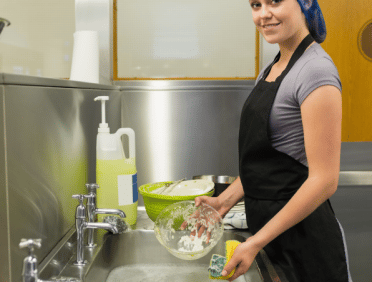Filter by
Understanding Physical Hazards in Food Safety
Foreign objects that accidentally contaminate food products and pose a risk to consumers are referred to as physical hazards in the context of food safety. These pollutants, which can include fragments of metal, glass, plastic, stones, and wood splinters, can lead to serious issues like cuts, choking, and dental damage.
In the management of food safety, one of the most important aspects is making sure that food is free from certain risk factors.
Sources of Physical Hazards
Food Preparation and Processing
During the many steps of food preparation and processing, there is the potential for the introduction of physical risks. Disruption of the machinery used in production might result in the release of shards of metal. It is also possible for the materials used in packaging to become sources of contamination, particularly if they become damaged or deteriorate. Inappropriate handling of food or preparation of food on surfaces that are not clean can lead to the spread of cross-contamination.
Common Examples
Some common examples of physical hazards include:
Metal fragments from processing equipment.
Glass shards from broken containers.
Plastic pieces from packaging.
Stones or dirt from raw agricultural products.
Bone fragments in meat products.
Distinguishing Between Physical, Biological, and Chemical Hazards
It is crucial to safeguard consumers and retain trust in the food sector by ensuring food safety by preventing physical dangers such as contamination. It is possible to considerably lessen the likelihood of contamination by adhering to the legislation of the United Kingdom, putting into action efficient detection and prevention procedures, and learning about the best practices.
Food firms are able to guarantee the highest possible quality and safety requirements for their products by utilising technology and cultivating a culture of safety.
Physical Hazards
The term “physical hazards” refers to the presence of foreign things that are tactile and can contaminate food. These dangers are more likely to result in physical injuries than sickness.
Biological Hazards
Hazards of a Biological Nature Bacteria, viruses, and parasites are examples of biological hazards. These organisms are responsible for foodborne diseases.
Chemical Hazards
Chemical dangers include potentially dangerous compounds that, if consumed, can be toxic. Some examples of chemical hazards include pesticides, cleaning agents, and food additives.
UK Regulations on Physical Hazards
Both the Food Safety Act of 1990 and the Food Hygiene (England) legislation of 2013 oversee the legislation that governs food safety in the United Kingdom. The Food Standards Agency (FSA) is responsible for enforcing these regulations. Because of these restrictions, food producers are required to guarantee that their products are risk-free and devoid of any pollutants, including those that could cause physical harm.
For the purpose of identifying and controlling possible risks, it is necessary to put into place systems that utilise Hazard Analysis and Critical Control Points (HACCP).
Identifying and Preventing Physical Hazards
Identifying Hazards
As a component of their HACCP plans, businesses are required to carry out exhaustive hazard studies, during which they must investigate each stage of production for potential contamination opportunities. Metal detectors, x-ray machines, and visual examinations are some of the main tools that are required for the proper detection of foreign items.
Safeguarding Against Contamination
It is important to do routine maintenance and calibration on the equipment as part of preventative measures.
Putting protective coatings on light fixtures and other glass fixtures.
The implementation of stringent sanitary measures and appropriate cleaning schedules, respectively.
Training employees to recognise and report any potential dangers they encounter.
Role of the Food Standards Agency (FSA)
The Food Safety Authority (FSA), which also provides information on identifying and controlling physical hazards, establishes and enforces food safety regulations. This agency ensures that food products are safe and free from contaminants by conducting inspections and audits, as well as educating businesses and consumers about the hazards associated with food safety and the best methods for addressing those risks.
Reporting Physical Hazards
Consumers are encouraged to report any physical dangers to their respective local Environmental Health Departments or the Food Safety Administration. Businesses are required to keep a record of occurrences and report them as part of their quality control procedures. This provides authorities with assistance in monitoring and addressing concerns with food safety.
Technological Advances in Detection
Metal detectors, x-ray machines, and optical sorters are examples of the types of advanced detection equipment that prove vital in the process of recognising and eliminating impurities. There is an increase in traceability thanks to technologies such as blockchain, which enables the rapid identification of contamination sources and the efficient recall of products.
Devices connected to the internet of things and digital monitoring systems give real-time data on the functioning of equipment and the conditions of the environment, which further helps to prevent contamination.
Case Studies of Physical Hazard Incidents
Notable occurrences in the United Kingdom shed light on the significance of implementing stringent quality control measures:
Glass in Baby Food (2014): As a result of customers reporting that they had discovered glass fragments in baby food jars, a supermarket decided to recall those jars and strengthen their inspection procedures.
Metal Shards in Ready Meals (2018): A recall was issued due to metal contamination from machines that were not functioning properly, highlighting the importance of doing routine maintenance.
Plastic Pieces in Dairy Products (2020): A dairy business withdrew batches of yoghurt after discovering plastic contamination, underscoring the significance of conducting stringent packaging checks.
Frequently Asked Questions (FAQs)
Physical risks are foreign things that can be included in food products and endanger customers in food safety. These risks can include anything like glass, plastic, stone, metal, or wood splinters. Injury from physical risks can include wounds, choking, or tooth problems.
The Food Standards Agency (FSA) in the UK offers rules and guidelines to support food companies in identifying and reducing these hazards, therefore guaranteeing the safety and quality of food items.
At every step of the preparation process, from harvesting and processing to packing and delivery, physical risks might contaminate food. When food processing equipment breaks down, for example, metal fragments might get into the meal. Comparably, shattered glass from light fixtures or bits of plastic from packing materials might unintentionally contaminate food goods.
When food is handled carelessly, as when it is prepared on surfaces with leftover debris, cross-contamination can also result. Tight maintenance and hygiene procedures need to be put in place and routinely checked in order to reduce these hazards.
Food dangers can include, for instance, glass shards from broken containers, metal bits from processing equipment, plastic bits from packaging, and stones or dirt from unprocessed agricultural products. Further possible physical pollutants include pieces of bone in meat products, wood splinters from pallets, and even jewellery or hair from food workers.
To identify and control these hazards in food processing environments, x-ray machines, metal detectors, and other screening technologies must be combined with comprehensive inspection protocols.
Because they include foreign items rather than chemicals or germs, physical dangers are not the same as biological or chemical hazards. The bacteria, viruses, and parasites that can result in foodborne diseases are classified as biological risks. Chemical risks are substances that, if swallowed, can be deadly, such as pesticides, cleaning products, or food additives. Bodily dangers are more likely to result in bodily injuries, even if biological and chemical hazards frequently result in illnesses.
To ensure general food safety and regulatory compliance, thorough food safety management systems must address all three types of dangers.
The Food Standards Agency (FSA) is in charge of enforcing food safety rules in the United Kingdom with relation to physical risks under the Food Safety Act 1990. By law, food companies must guarantee that their goods are free of any impurities, including physical risks, and safe to eat.
Further stipulating particular hygiene standards to avoid contamination are the Food Hygiene (England) Regulations 2013. Regular inspections are used to track adherence to these rules, and companies must put Hazard Analysis and Critical Control Points (HACCP) systems in place to find and manage possible risks.
Through in-depth hazard evaluations as part of their HACCP plans, businesses can find physical dangers in their food items. This entails looking at every phase of the food production process to find places where physical pollutants could be introduced. For the purpose of finding foreign objects, x-ray machines, metal detectors, and visual checks are often utilised.
It is also essential for staff training on the value of seeing and reporting such risks. Strict cleaning routines and routine equipment maintenance can lower the possibility of contamination from other sources or machines.
Companies preparing food should put in place thorough quality control procedures to avoid physical risks. This covers routine calibration and maintenance of the machinery to guarantee that no parts fall off and contaminate food. Covering lights and other glass fixtures can prevent glass breakage. It is also imperative to put into place stringent hygiene procedures, such as washing and sanitising surfaces and equipment properly.
To reduce their chance of physical contamination, food workers should avoid wearing jewellery and use suitable protective garments. A safe food processing facility depends on employee training on physical hazard identification and management.
The Food Safety Agency (FSA) sets and enforces food safety rules and regulations, which are essential to addressing physical dangers in food. Food firms can get advice from the FSA on how to use HACCP systems to identify and manage physical hazards. It does audits and inspections to make sure food safety regulations are being followed, and, when needed, it takes enforcement action.
To help guarantee that food products are safe, hygienic, and free of physical contaminants, the FSA also educates consumers and businesses on food safety hazards and best practices.
Physical risks in food should be reported in the UK to the local Environmental Health Department, which is a part of local government. Should a consumer discover physical risks in their food, they should get in touch with the Food Standards Agency (FSA) or the Environmental Health Department of their local council.
Businesses must report and record physical contamination events as part of their internal quality control procedures. Authorities can better monitor and handle food safety concerns thanks to this reporting, which also guarantees that the required remedial steps are taken to stop their recurrence.
Depending on the kind and amount of contamination, eating food tainted with physical dangers may cause a number of health problems. Broken glass or metal fragments are examples of small, pointed objects that can injure the mouth, throat, and digestive system and result in infection or bleeding. Bigger things can be a choking hazard, especially for little children and senior citizens.
Another frequent result is a dental injury. When the ingestion of some foreign items is significant, surgery may be necessary to remove the danger and fix any internal damage.
Through extensive training programmes, including the detection of possible pollutants, correct handling techniques, and the significance of hygiene, employees can be trained to identify and prevent physical dangers in food. Instructions should cover how to utilise metal detectors and x-ray machines for detection, how to clean food processing rooms, and how to inspect raw materials.
Staff members must also be kept educated and alert through regular refresher training and updates on new laws or technology. Physical contamination is much less likely when workers are encouraged to have a culture of responsibility and safety.
Using several levels of inspection at every stage of the production process is one of the best ways to check food for physical risks. This can entail routine product sampling and testing, automated detection devices like metal detectors and x-ray equipment, and visual inspections by qualified staff. Correct identification of pollutants depends on the maintenance and routine calibration of inspection equipment.
Food quality and safety are maintained by clearly defining procedures for managing and recording any physical hazard discoveries and for taking remedial action.
When food packaging is improperly designed, produced, or handled, it might pose a physical risk. For instance, pieces of broken or improperly sealed metal, glass, or plastic packaging materials could contaminate food products. Non-food-safe packaging materials can break down or release dangerous particles into the food.
Businesses should utilise premium, food-grade packaging materials and strictly enforce quality control procedures throughout the packing process to reduce these dangers. Regular inspections and appropriate training of personnel handling packaging materials can lower the possibility of contamination even more.
Companies operating in the UK that do not manage physical risks in food risk serious legal repercussions. These might be penalties, recalls of products, and, in more extreme circumstances, Food Safety Act 1990 prosecution. Local governments and regulatory agencies like the FSA are able to uphold these regulations and penalise noncompliance.
A company’s reputation, consumer trust, and substantial financial losses can all be severely harmed by neglecting to handle physical dangers. To prevent such effects and preserve customer safety, food safety laws must be followed.
Hazard Analysis and Critical Control Points (HACCP), which identifies potential points in the food production process where contaminants might enter, addresses physical hazards by setting up controls to prevent or eliminate these hazards. This methodical method includes a complete hazard analysis, critical control point (CCP) determination, critical limit setting, monitoring protocols, and corrective action implementation.
The HACCP plan is able to manage the physical hazards thanks to ongoing verification and documentation. Food items are safer and of higher quality when hazards are proactively identified and managed using HACCP.
Metal detectors, x-ray machines, and optical sorting systems are among the equipment advised for identifying physical dangers in food preparation. Whereas x-ray equipment can identify a broad range of foreign materials, including glass, plastic, and stones, metal detectors are good at recognising metal contamination. By using cameras and sensors, optical sorting machines identify and exclude alien objects according to their size, shape, and colour.
The accuracy and dependability of this equipment depend on routine maintenance and calibration. Including these technologies in an all-encompassing food safety plan reduces the possibility of physical contamination.
Customers who carefully examine the item before eating it can identify any bodily risks. Among these is looking for any obvious indicators of contamination, including odd forms, hues, or textures. Look out for any unexpected materials when opening packaged food. Customers may also keep informed about possible risks by reading product recalls and warnings from regulatory agencies such as the FSA.
Customers should never eat anything that seems tainted and should get further information from the maker or reseller if in question.
Should consumers discover a physical hazard in their food, they should stop using the product right away and save the package and foreign object as proof. Giving specifics about the product and the kind of contamination, they should report the occurrence to the manufacturer or merchant. Consumers may notify the FSA or their local Environmental Health Department of the hazard.
This facilitates the investigation by the authorities and the taking of suitable steps, such as recalls or inspections. Making sure that such situations are documented raises the bar for food safety generally and stops them from happening again.
Indeed, handling physical dangers has particular rules designed for various food types. Guidelines for meat products mostly concentrate on avoiding bone fragment contamination and guaranteeing the correct maintenance of cutting and grinding equipment. To stop contamination from processing equipment and packaging materials, dairy products need strict controls.
Produce standards stress both checking for contamination from harvesting tools and thoroughly washing to remove stones, soil, and other foreign things. For every food category, the Food Standards Agency (FSA) offers comprehensive advice on best practices to guarantee safety and regulatory compliance.
Because food labels give customers vital information about the product, including directions for safe handling, preparation, and storage, they are essential in preventing physical risks. Labels may indicate whether the product has undergone stringent quality control procedures to guarantee that it is free of physical impurities and point out any possible hazards.
Clearly identifying packing materials and recycling instructions reduces the risk of contamination from improper handling. Regulatory bodies require exact and instructive labelling if consumers are to be safe and knowledgeable.
For continued safety and compliance, food companies should routinely analyse the risk of physical hazards. The kind of food produced, how involved the production process is, and past contamination events can all affect how often these evaluations are conducted. Generally speaking, risk assessments should be carried out once a year at the very least, and more often in the event of major production process modifications, new equipment installation, or contamination incidents.
Regular evaluation and ongoing observation enable the efficient identification and reduction of possible risks.
In the UK, recalling food goods because of physical hazard contamination consists of a few stages:
- Identification and Assessment: Next, the contamination is recognised, and then an evaluation is carried out in order to ascertain the scope and gravity of the risk.
- Notification: The company is required to report the contamination to the Food Standards Agency (FSA) as well as the authorities in the applicable jurisdiction.
- Decision to Recall: A decision to recall the affected product is taken after the decision to recall the product is based on the assessment and the recommendations from regulatory authorities.
- Public Notification: The recall is conveyed to the general public using a variety of means, including news releases, social media, and notices posted at points of sale.
- Product Retrieval: The company is responsible for organising the process of retrieving contaminated products from the market at large and from individual customers.
- Corrective Actions: An investigation is carried out in order to determine the source of the contamination, and corrective actions are put into place in order to forestall the occurrence of similar instances in the environment.
Follow-Up: As a follow-up, an evaluation of the efficiency of the recall and the corrective steps is carried out, and a report is then presented to the regulatory authorities.
Food-related physical hazards can be found and prevented in large part because of technology. Food goods can have pollutants identified and removed using sophisticated detection equipment like metal detectors, x-ray machines, and optical sorters. Automated inspection technologies are superior to human capacity for quick, precise examinations. Because blockchain technology improves traceability, it becomes easier to quickly identify the sources of contamination and carry out effective recalls.
IoT devices and digital monitoring systems can offer real-time information on environmental factors and machine performance, therefore preventing contamination before it starts.
- Glass Contamination in Baby Food: In 2014, glass pieces were found in jars of baby food, prompting a large UK retailer to recall the product. The need for strong quality control and inspection procedures was brought to light after multiple customers reported discovering glass fragments in the product.
- Metal Shards in Ready Meals: A well-known ready meal producer had to issue a recall in 2018 because of metal shards in their products. The requirement of routine equipment maintenance and monitoring was highlighted when contamination was linked to a processing equipment failure.
- Plastic Pieces in Dairy Products: A dairy firm withdrew many batches of yoghurt in 2020 after finding plastic fragments. The link between the contamination and the defective packaging materials emphasises the need for thorough supplier quality inspections and packaging inspections.
Generally speaking, UK laws governing physical risks are in line with international food safety standards set forth by organisations like the International Organisation for Standardisation (ISO) and the Codex Alimentarius Commission. The need for hazard analysis, risk assessment, and control measure implementation to avoid contamination is emphasised in both sets of standards.
The Food Standards Agency (FSA) of the United Kingdom, however, might have more particular standards based on national demands and legal systems.
While both international and UK standards require the adoption of HACCP, the specific rules and enforcement methods may vary to reflect regional legislative environments and business practices.















